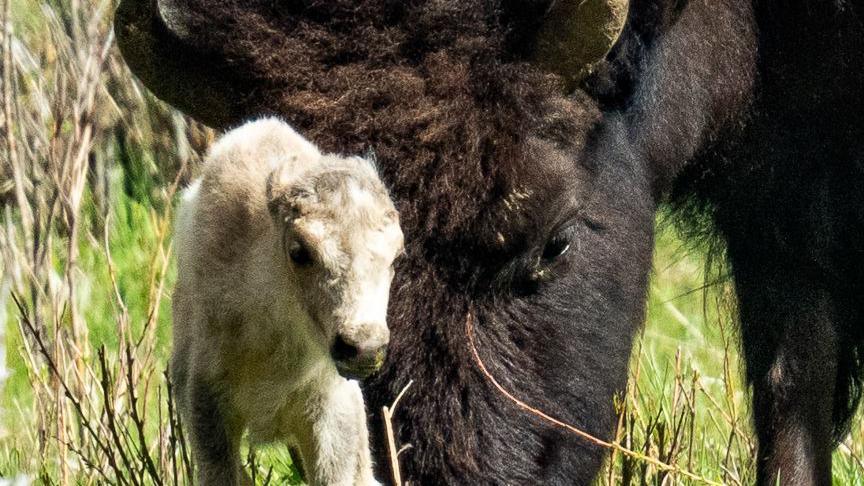Native Americans see omen in Yellowstone's rare white bison

Photographer Erin Braaten called the experience 'overwhelming'
- Published
An incredibly rare white bison calf has been photographed in Yellowstone National Park, exciting Native American tribes who view it as a religious sign heralding major change.
It was spotted in the Lamar Valley area, and is the first white bison to be born in the last wild herd in the US, according to modern records.
Other recent white bison births have happened in captivity and from parents that contained cow DNA. Tribes consider a wild birth more religiously significant.
Montana photographer Erin Braaten took photos of the young buffalo in the Lamar Valley on 4 June while visiting the park with three of her eight children.
Stuck in traffic caused by a slow-moving herd, she noticed the young calf across a river, nearly 100 metres (330ft) away, and initially mistook it for a coyote because of its sandy light colour.
"There were so many different thoughts and emotions," Braaten told the ┤¾¤¾┤½├¢.
"It was so amazing. I thought I'd have a better chance of capturing Bigfoot than a white bison calf."
The birth of a white buffalo is a sacred event for many Native tribes of the Great Plains, including the Lakota people, who believe that it relates to a time around 2,000 years ago when food was scarce and the bison were rarely seen.
The Lakota legend tells of a beautiful woman who appeared and delivered the gifts of a sacred pipe and bundle to the people.
The woman told them she would return to restore harmony in a troubled world, and then rolled on the ground four times, changing colour each time before becoming a white buffalo calf.
Her departure led the bison to return, and white buffalos are now seen as a sign that prayers are being heard and that change is coming.
The white buffalo woman is considered the central prophet in the theology of many tribes including the Sioux, Cherokee, Comanche and Navajo.
Her story is often likened to that of Jesus in Christianity.
Simon Moya-Smith, an Oglala Lakota writer who was also raised on the white buffalo woman's story, told the ┤¾¤¾┤½├¢ that tradition says the arrival of a white calf is seen as both a "blessing and a warning".
Every time a white calf is seen, "you have this prophecy of something good or something bad will happen. But we know that it's going to be great - great in the sense that it's going to be significant".
Mr Moya-Smith said that tribes were working to interpret the meaning of the calf's arrival.
Yellowstone park officials have not officially confirmed the birth of the calf.
An event to celebrate its arrival is planned for 26 June in the town of West Yellowstone, Montana, and is being hosted by Buffalo Field Campaign, a group that advocates for the buffalo.
Lakota elders will attend the event and other tribes may send delegates.
Chief Arvol Looking Horse, who is the 19th generation keeper of the pipe believed to have been given by the white buffalo woman, said that the calf's arrival was a sign "we must do more".
"All nations should come together at their sacred places and unify with us in prayer," he said. He called the calf's arrival "a blessing and a warning".
"I'm so overwhelmed. It's a miracle," the spiritual leader told ┤¾¤¾┤½├¢ News on Thursday.
"It makes my hairs stand up just to even talk about it, because I can't believe this is happening - the spirit of the white buffalo calf woman sending a message to us."
He noted that the calf seen in Yellowstone had black eyes, a black nose and black hooves, as the prophecy predicted.
The National Bison Association estimates that only one to two white bison are born each year.
According to Chief Looking Horse, there has been a white buffalo alive in North America at almost all times since 1994, when a calf named Miracle was born on a farm in Wisconsin.
Bison charges at nine-year-old girl at Yellowstone National Park